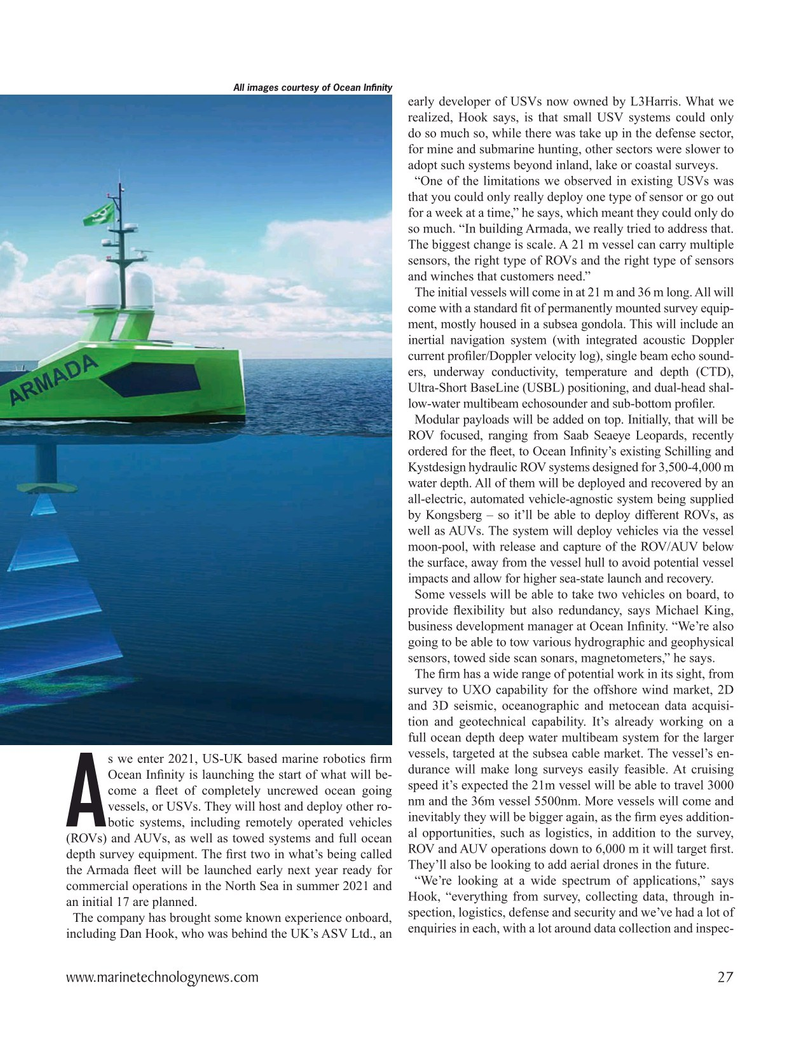
Page 27: of Marine Technology Magazine (January 2021)
Underwater Vehicle Annual
Read this page in Pdf, Flash or Html5 edition of January 2021 Marine Technology Magazine
All images courtesy of Ocean In? nity early developer of USVs now owned by L3Harris. What we realized, Hook says, is that small USV systems could only do so much so, while there was take up in the defense sector, for mine and submarine hunting, other sectors were slower to adopt such systems beyond inland, lake or coastal surveys. “One of the limitations we observed in existing USVs was that you could only really deploy one type of sensor or go out for a week at a time,” he says, which meant they could only do so much. “In building Armada, we really tried to address that.
The biggest change is scale. A 21 m vessel can carry multiple sensors, the right type of ROVs and the right type of sensors and winches that customers need.”
The initial vessels will come in at 21 m and 36 m long. All will come with a standard ? t of permanently mounted survey equip- ment, mostly housed in a subsea gondola. This will include an inertial navigation system (with integrated acoustic Doppler current pro? ler/Doppler velocity log), single beam echo sound- ers, underway conductivity, temperature and depth (CTD),
Ultra-Short BaseLine (USBL) positioning, and dual-head shal- low-water multibeam echosounder and sub-bottom pro? ler.
Modular payloads will be added on top. Initially, that will be
ROV focused, ranging from Saab Seaeye Leopards, recently ordered for the ? eet, to Ocean In? nity’s existing Schilling and
Kystdesign hydraulic ROV systems designed for 3,500-4,000 m water depth. All of them will be deployed and recovered by an all-electric, automated vehicle-agnostic system being supplied by Kongsberg – so it’ll be able to deploy different ROVs, as well as AUVs. The system will deploy vehicles via the vessel moon-pool, with release and capture of the ROV/AUV below the surface, away from the vessel hull to avoid potential vessel impacts and allow for higher sea-state launch and recovery.
Some vessels will be able to take two vehicles on board, to provide ? exibility but also redundancy, says Michael King, business development manager at Ocean In? nity. “We’re also going to be able to tow various hydrographic and geophysical sensors, towed side scan sonars, magnetometers,” he says.
The ? rm has a wide range of potential work in its sight, from survey to UXO capability for the offshore wind market, 2D and 3D seismic, oceanographic and metocean data acquisi- tion and geotechnical capability. It’s already working on a full ocean depth deep water multibeam system for the larger vessels, targeted at the subsea cable market. The vessel’s en- s we enter 2021, US-UK based marine robotics ? rm durance will make long surveys easily feasible. At cruising
Ocean In? nity is launching the start of what will be- come a ? eet of completely uncrewed ocean going speed it’s expected the 21m vessel will be able to travel 3000 nm and the 36m vessel 5500nm. More vessels will come and vessels, or USVs. They will host and deploy other ro-
Abotic systems, including remotely operated vehicles inevitably they will be bigger again, as the ? rm eyes addition- (ROVs) and AUVs, as well as towed systems and full ocean al opportunities, such as logistics, in addition to the survey, depth survey equipment. The ? rst two in what’s being called ROV and AUV operations down to 6,000 m it will target ? rst. the Armada ? eet will be launched early next year ready for They’ll also be looking to add aerial drones in the future. “We’re looking at a wide spectrum of applications,” says commercial operations in the North Sea in summer 2021 and
Hook, “everything from survey, collecting data, through in- an initial 17 are planned. spection, logistics, defense and security and we’ve had a lot of
The company has brought some known experience onboard, enquiries in each, with a lot around data collection and inspec- including Dan Hook, who was behind the UK’s ASV Ltd., an www.marinetechnologynews.com 27
MTR #1 (18-33).indd 27 1/25/2021 9:08:22 AM

 26
26

 28
28
